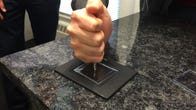
Corning
Corning, whose Gorilla Glass display covers front Apple’s iPhones and Samsung’s Galaxy smartphones, is developing a new material that combines the toughness of Gorilla with a scratch-resistance that comes close to sapphire.
The developmental Gorilla Glass-like composite, currently dubbed Project Phire, was announced Friday at a New York investor meeting by Corning executive James Clappin. He said the company plans to start selling the material later this year, though provided few other details.
“We told you last year that sapphire was great for scratch performance but didn’t fare well when dropped,” Clappin, president of Corning Glass Technologies, told the crowd at the event. “So, we created a product that offers the same superior damage resistance and drop performance of Gorilla Glass 4 with scratch resistance that approaches sapphire.”
Corning makes most of its money from glass for TV displays and fiber-optics, but Gorilla Glass has been an important growth area for the company. The material is now the dominant player in hardened glass for mobile devices, fronting about 3 billion electronics, including Apple’s new iPhone 6 and iPhone 6 Plus and Samsung’s Galaxy Note Edge and Galaxy Note 4.
But the Gorilla Glass business was under pressure for much of last year amid concerns that Apple — its most important customer — would flip from using Gorilla to synthetic sapphire, an extremely hard material that is incredibly difficult to scratch. In the end, after Apple poured hundreds of millions of dollars into a sapphire maker, that supplier — GT Advanced Technologies — unexpectedly filed for bankruptcy protection late last year and severed ties with Apple in a public disagreement.
While Corning avoided what could have become a big hit to Gorilla’s reputation, the episode exposed a weakness in the material — although it may not break, it scratches much more easily. So Corning secretly worked on a display cover that’s both highly damage-resistant and scratch-resistant, potentially bringing together the strengths of both products. That material could help Corning prevent a future competitor from usurping its place as the leading display-cover maker for smartphones and tablets.
Also, Project Phire could help Corning snag more of the smartwatch market, where Gorilla is already used in several Samsung products and the Motorola Moto 360. Sapphire has been a used for a long time in high-end watches, thanks to its scratch resistance and luxurious quality. Apple, too, plans on using sapphire covers for some versions of Apple Watch, which will be coming out in April.
RELATED STORIES
- Corning’s newest Gorilla Glass gets twice as tough
- For Gorilla Glass testers, life is a daily grind (and scratch and drop…)
- Six things we learned from Apple’s spat with GT Advanced
For its part, Corning has repeatedly said sapphire is a poor alternative to its glass in mobile devices because it shatters easily when dropped. Still, Project Phire shows that Corning’s thinking on how it develops its glass may have shifted since its sapphire scare, with the company emphasizing scratch-proofing as much as preventing breakages.
A handful of niche phones use sapphire, including the heavy-duty Kyocera Brigadier and Vertu Signature Touch, which starts at $10,800. Also, despite GT Advanced’s implosion, several analysts continue to see sapphire as a better product versus Gorilla, and have expected more handset makers to switch eventually to using sapphire.
Corning in November unveiled Gorilla Glass 4, which offers about twice the toughness as its predecessor, Gorilla Glass 3. Also, the new material can be made 25 percent thinner, but in that case will be just as damage resistant as a thicker piece of Gorilla Glass 3. While Corning has showed off the damage-resistance of the new material, it made less progress in cutting down on scratches.
Also at the investor presentation Friday, Corning executives discussed the company’s Iris glass, first unveiled at last month’s Consumer Electronics Show. Corning claims that Iris can help manufacturers build new TVs that are as thin as smartphones and require minimal edges around the sides.


Now playing:
Watch this:
Meet the people who torture Gorilla Glass for a living
3:24



